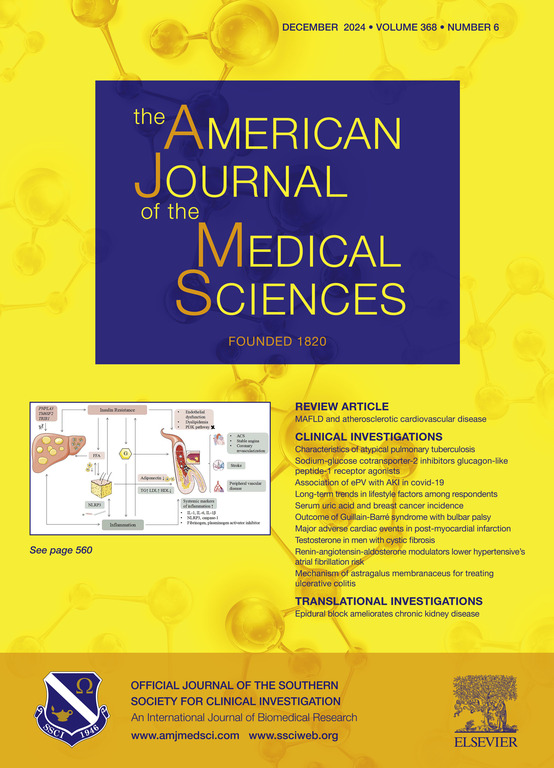基于 CT 的身体成分参数可预测克罗恩病患者对英夫利西单抗失去反应。
IF 2.3
4区 医学
Q2 MEDICINE, GENERAL & INTERNAL
引用次数: 0
摘要
目的:英夫利昔单抗是治疗克罗恩病(CD)的一线生物制剂:英夫利昔单抗是治疗克罗恩病(Crohn's disease,CD)的一线生物制剂。该研究旨在探讨身体成分参数与英夫利昔单抗治疗CD患者LOR之间的关系。方法:回顾性入选温州医科大学附属第一医院2015年6月至2021年12月收治的118例接受英夫利昔单抗治疗的CD患者。通过计算机断层扫描(CT)分析了患者的身体成分。主要结局指标为一年的LOR。患者被分为缓解组和LOR组,以分析身体成分参数与英夫利西单抗LOR之间的关系:结果:LOR组的肌少症发生率高于缓解组(83.7%对60.0%,P=0.008)。多变量分析显示,女性患肌肉疏松症的风险低于男性(OR=0.30,95%CI 0.11-0.81,P=0.017);体重指数与肌肉疏松症显著相关(OR=0.68,95%CI 0.56-0.83,P 结论:肌肉疏松症被认为是一种严重的慢性疾病:肌肉疏松症是英夫利西单抗治疗患者发生LOR的一个风险因素。本文章由计算机程序翻译,如有差异,请以英文原文为准。
CT-based body composition parameters predict the loss of response to infliximab in patients with Crohn's disease
Objective
Infliximab is a first-line biologic agent for the treatment of Crohn's disease (CD), in which loss of response (LOR) remains a challenge in the treatment of patients with CD. The study aimed to explore the association between body composition parameters and LOR to infliximab in CD patients.
Methods
118 patients with CD admitted to the First Affiliated Hospital of Wenzhou Medical University and treated with infliximab from June 2015 to December 2021 were retrospectively enrolled. The body composition of patients was analyzed by computed tomography (CT). The primary outcome measure was the one-year LOR. Patients were divided into the Remission group and the LOR group to analyze the association between body composition parameters and the LOR to infliximab.
Results
The rate of sarcopenia in the LOR group was higher than in the Remission group (83.7% vs. 60.0%, P=0.008). Multivariate analysis showed that females had a lower risk of sarcopenia than males (OR=0.30, 95% CI 0.11-0.81, P =0.017); BMI was significantly associated with sarcopenia (OR=0.68, 95% CI 0.56-0.83, P <0.001); L1 CD and L2 CD had a lower risk of sarcopenia than L3 CD (OR=0.29, 95% CI 0.10-0.83, P =0.021; OR=0.25, 95% CI 0.07-0.87, P=0.028).
Conclusions
Sarcopenia was identified as a risk factor for developing LOR in infliximab-treated patients.
求助全文
通过发布文献求助,成功后即可免费获取论文全文。
去求助
来源期刊
CiteScore
4.40
自引率
0.00%
发文量
303
审稿时长
1.5 months
期刊介绍:
The American Journal of The Medical Sciences (AJMS), founded in 1820, is the 2nd oldest medical journal in the United States. The AJMS is the official journal of the Southern Society for Clinical Investigation (SSCI). The SSCI is dedicated to the advancement of medical research and the exchange of knowledge, information and ideas. Its members are committed to mentoring future generations of medical investigators and promoting careers in academic medicine. The AJMS publishes, on a monthly basis, peer-reviewed articles in the field of internal medicine and its subspecialties, which include:
Original clinical and basic science investigations
Review articles
Online Images in the Medical Sciences
Special Features Include:
Patient-Centered Focused Reviews
History of Medicine
The Science of Medical Education.

 求助内容:
求助内容: 应助结果提醒方式:
应助结果提醒方式:


